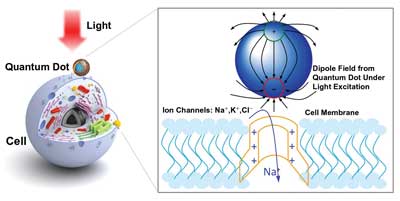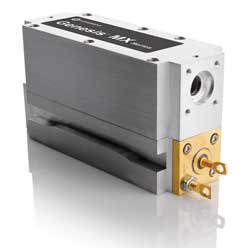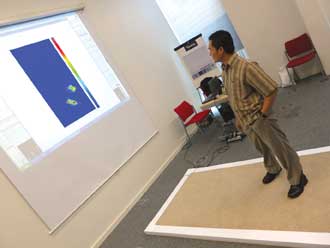An aging world population may be the single biggest social challenge of this century – and photonic technologies and innovation could play a major role in helping us all make the most of this global trend.
On the occasion of World Health Day 2012, the World Health Organization (WHO) called the current wave of population aging one of the biggest social transformations: It will result in a world with not only more older people than children, but also with more very old people than ever before.
A report last year from the United Nations Population Fund and HelpAge International, Ageing in the Twenty-First Century, broke it down. Currently, the annual total of 60th birthdays is 58 million; by 2050, one in five people will be 60 or older. It is a phenomenon occurring in developed and developing nations alike.
Aging “is a triumph of development,” the report says. “Increasing longevity is one of humanity’s greatest achievements.” But the celebration bells turn quickly to warning alarms because the world may not be ready for a population with many more persons over 60 than under it.
 Experts are concerned about how the nations of the world will affordably care for all of those senior citizens. How do we keep them healthy and active – productive, even – and keep them safe in their own homes as they age? How do we design the future so that they can travel around town, buy groceries, make doctor visits and do all the things people do in the course of a day?
Experts are concerned about how the nations of the world will affordably care for all of those senior citizens. How do we keep them healthy and active – productive, even – and keep them safe in their own homes as they age? How do we design the future so that they can travel around town, buy groceries, make doctor visits and do all the things people do in the course of a day?
Technology is part of the answer
Several technologies likely will have an especially strong impact on the quality of life for aging citizens. A number of experts agree that remote monitoring, telehealth and mobile health technologies as well as devices that allow aging safely at home will become ever more important as our population ages.
The ubiquitousness of smartphones and other devices is changing the game in many ways, experts say, including improving the pace of decision making in senior health care. (For more information about smartphones and their impact on the photonics industry, see “Smartphones Move from Social Media to Social Medicine,” by senior editor Melinda Rose, beginning on page 68.)
From brain disorder research to eye health and vision correction and much more, it is clear that photonic technologies will play a significant role in this future.
Aging research
While nations and governments discuss the social implications of the changing demographics, researchers are investigating physical aging from every angle. It is not surprising that the neurological aspects of aging are getting a lot of attention and that photonic technologies are being employed in this critical research.
For example, in late 2011, two researchers at the University of Texas at Austin received a Transformative Research Projects award from the National Institutes of Health (NIH) to continue their work using high-speed optofluidics to study the entire nervous system as it relates to aging and disease. The NIH awards are given to help “catalyze giant leaps forward for any area of biomedical research, allowing investigators to go in entirely new directions,” said James M. Anderson, director of the Division of Program Coordination, Planning and Strategic Initiatives.
Also in 2011, William Seeley, an associate professor of neurology at the Memory and Aging Center at the University of California, San Francisco, was named a MacArthur fellow, receiving one of 22 no-strings-attached $500,000 grants from the John D. and Catherine T. MacArthur Foundation. Seeley’s award recognized his contributions to neurology by integrating microscopy, magnetic resonance imaging and clinical examination to explore the structural, functional and behavioral aspects of human neurodegenerative disease, concentrating on frontotemporal dementia.
Minding our minds
Dementia describes a loss of brain function that affects behavior, language, thinking and more, and is a factor in a number of diseases, including Alzheimer’s and Parkinson’s. Nearly 35.6 million people worldwide are living with some form of dementia, according to a report released by WHO last April. The organization expects that number to double by 2030 and more than triple by 2050.
Treating and caring for people with dementia currently costs the world more than $604 billion per year, including health and social care as well as loss of income for the afflicted and those who care for them, WHO said.
From research to diagnosis to treatment, photonic technologies are both current tools and applications with great promise for changing the future course of many diseases of which dementia is a symptom.
In mouse model experiments, investigators at Technical University Munich (TUM) discovered last year that correlations exist between increases in both soluble and plaque-forming beta-amyloid – a protein implicated in the disease process of Alzheimer’s – and dysfunctional developments, including individual cortical neurons, sensory cognition, neuronal circuits and behavior.
Using two-photon calcium imaging, researchers observed that Alzheimer’s-related changes in the visual cortex occurred at the single-cell level. The changes could reveal that Alzheimer’s disease progresses in a specific order.
“An important conclusion from this study is that the Alzheimer’s disease-related changes on all levels – including behavior, cortical circuit dysfunction and the density of amyloid plaques in diseased brains – progress in parallel in a distinct temporal order,” said professor Arthur Konnerth, a Carl von Linde Senior Fellow of the TUM Institute for Advanced Study. “In the future, the identification of such stages in patients may help researchers
pinpoint stage-specific and effective therapies, with reduced levels of side effects.”
At the University of Washington early last year, researchers demonstrated that light emitted from electrons confined by quantum dots can activate and control targeted brain neurons; the technique offers a noninvasive method for studying cell communication and the contribution of specific cells to brain disorders. The approach offers an alternative to photostimulation of cells that first must be genetically modified to flip the switch. Compared to previous methods, the quantum dot technique is more localized and should help advance our understanding
of brain disorders such as Parkinson’s disease, Alzheimer’s and severe depression.

Optically excited quantum dots in proximity to a cell control the opening of ion channels. Adapted from Jiang et al, Chemistry of Materials, 2006, 18 (20), pp. 4845-4854.
“Many brain disorders are caused by imbalanced neural activity,” said biophysicist Fred Rieke, a member of the University of Washington team. “Techniques that allow manipulation of the activity of specific types of neurons could permit restoration of normal – balanced – activity levels.”
To use the technique in living tissue, the quantum dots would have to be modified to target specific cells upon injection and would have to be made nontoxic.
Clear-sighted developments
While seeing deeper into the body’s neurological mechanisms is driving both understanding and treatment of some of mankind’s cruelest diseases, age-related sight-robbing conditions also are seeing improved prognoses through advanced applications of light.
In an article for Photonics.com last September, senior editor Melinda Rose reported on growth in the ophthalmic laser market, drawing a connection between the world’s aging population and the market’s short- and long-term prospects.
“In the US alone, the 90-and-older population nearly tripled over the past three decades, reaching 1.9 million in 2010, according to a November 2011 report by the US Census Bureau, supported by the National Institute on Aging. Over the next four decades, this population is projected to more than quadruple,” Rose wrote.
Aging eyes are subject to cataracts – a clouding of the eye’s natural lens. More than 15 million cataract surgeries are performed worldwide each year to replace the damaged lens with an intraocular one, Rose reported.
A January 2012 market report on ophthalmic lasers published by Global Industry Analysts revealed that, “certain new technological developments in laser surgery are believed to offer benefits beyond vision correction and attract significant demand in the future.” Further, the report said, “Application of laser technology in early diagnosis and the detection of certain eye disorders in conjunction with imaging technologies such as OCT [optical coherence tomography] is another factor that would boost growth of the laser eye correction market in the future.”
In November, laser-based medical systems provider Iridex Corp. reported licensing its MicroPulse photocoagulation technology to Quantel Medical for use in clinical ophthalmic lasers. MicroPulse, a tissue-sparing laser technology, gives ophthalmologists a noninvasive treatment for diseases that threaten eyesight. It works by electronically “chopping” the laser emission into trains of microsecond pulses, enabling physicians to control the effects on target tissues.
“There is a significant need in the marketplace for efficient and durable therapies for retinal diseases associated with the growth of diabetes and the aging population,” said Iridex President and CEO Will Moore at the time the license was announced.
One such retinal disease is age-related macular degeneration, which is estimated to occur in 1 of 2000 people in the US and other developed countries, according to a report on the Genetics Home Reference page, a service of the US National Library of Medicine. “The condition currently affects several million Americans, and the prevalence is expected to increase over the coming decades as the proportion of older people in the population increases,” the report’s authors wrote.

The Genesis 577-nm optically pumped semiconductor laser is wavelength-optimized for treatment of wet-form age-related macular degeneration.
The disease has two forms: dry and wet. The less common, wet-form, is more likely to cause blindness.
Last June, Coherent Inc. reported that its sales of lasers for ophthalmic therapeutic applications had exceeded 10,000 units. Included in that count were pulsed excimer ultraviolet lasers for lasik vision correction and continuous-wave solid-state lasers with green or yellow output for use in photocoagulation to treat wet-form age-related macular degeneration. The company has manufactured lasers used for photocoagulation for decades.
Matthias Schulze is Coherent’s Life Sciences/Medical Segment director. He believes – “Absolutely!” – that photonic technologies are in a good position to help society cope with the aging demographic. In the case of wet-form age-related macular degeneration, he said that by listening to doctors, they came to learn that what was desired was a laser that hit exactly at the main absorption peak of oxygenated hemoglobin: 577 nm. “An excitation source at 577 nm needs less laser power to drive the photocoagulation process,” Schulze said, adding that this means “less power and more patient comfort.”
It has become the market standard for this application, he said, but the impact of ophthalmic lasers doesn’t end there.
“What I see is using lasers for cataract surgery, and we certainly have an eye on that application,” Schulze said. “If you use a laser instead of a knife, [you get a] better, predictable and safer procedure.”
Schulze said that millions of people are undergoing this procedure, which is covered by social security programs in most countries. “It is a reasonably cheap surgery, and [afterward] you can see better.” While some people have a strong genetic predisposition for cataracts, Schulze said, those who reach the age of 70 will certainly encounter it.
“That is why it is a strong emerging market,” Schulze said. But he cautioned that “everyone in this market has to figure out how to make it work.”
In nonlaser cataract surgery, the surgeon removes the natural lens and slips in a replacement. Using the laser, the surgeon can customize the procedure by implanting an ocular lens that works best for the patient. “The laser facilitates the use of higher-value-added lenses,”
he said.
This means that it offers options. The doctor can now ask whether a patient is willing to pay a surcharge for better vision acuity, in addition to the cataract removal, Schulze suggested.
He expanded on this 100,000-foot view of the challenges this option presents: A problem will emerge if getting the better procedure for cataracts is promoted and the burden is put on insurance. This will be the ongoing discussion in many areas, he said.
Schulze believes that the solution is not to put everything on insurance, which he predicts would ignite a collapse. Instead, find a compromise, he said. With insurance, anyone with cataracts can be made to see even a little bit better, Schulze said, while someone who can pay for it himself can have customized vision improvements with cataract surgery.
All the bigger companies are working on solutions, according to Schulze. It means “big business on the horizon.”
“The cataract is a great example of where photonics will open up a greater value-add to patients at extra cost,” he said, adding that cataract surgery is the current buzz at ophthalmic conferences.
“The lasik stuff in most cases is a lifestyle surgery,” he said, that offers a choice between wearing glasses and not having to wear them. The big thing is the cataract surgery. Incorporating a refractive procedure with cataract surgery means the surgeon can put in a multifocal lens – and can essentially kill three birds with one stone: eliminate the cataract, eliminate the need for long-distance lasik and take care of the presbyopia that kicks in with age and correct that as well. The safety of this is being studied, Schulze said.
Making the business feasible is still the challenge. Schulze believes the answer lies in drawing a line between “must have” and “nice to have” results. You cannot ask people for a surcharge for a “safer” cataract procedure, but you can bill extra for better (customized) vision. Authorities are thinking along these lines, he said. “I’m very confident this will rapidly gain adoption.”
Home safe home
Although falls are only one risk faced by aging people living alone or in their own homes, they present a significant problem. Older people are at greater risk for falls and, in the US, 20 to 30 percent of seniors who fall will “suffer moderate to severe injuries such as bruises, hip fractures or head traumas,” according to the World Health Organization. The falls may result from the physical, sensory and cognitive changes that come with aging, WHO reported.
As many as 30 to 40 percent of community-dwelling older people fall each year, according to the University of Manchester in the UK. This is the most serious and frequent accident in the home and accounts for 50 percent of hospital admissions in the 65-and-older age group.

A “smart” carpet developed at the University of Manchester has an underlay of plastic optical fibers that bend when walked upon. It can detect when someone has fallen and also can help predict walking patterns.
In September, researchers at the university announced the development of a “smart” carpet that can detect when someone has fallen and that also can help predict walking patterns, as an early warning system. The interdisciplinary team included members of three academic schools and the Photon Science Institute at the university. They used a tomographic technique that maps 2-D images using light propagating under the carpet’s surface.
The carpet has an underlay of plastic optical fibers that bend when walked upon. Tiny electronics at the carpet’s edges act as sensors and relay signals to a computer, where they are analyzed to reveal the image of the footprint and to identify gradual changes in walking behavior as well as falling or tripping.
The “magic” carpet could be vital not only for helping people in the immediate aftermath of a fall, but also for identifying subtle changes in walking habits that might not be spotted by a family member or caretaker, said Dr. Patricia Scully of the Photon Science Institute, who led the research team.
“This is really exciting work at the forefront of research using technologies to prevent falls,” said professor Chris Todd of the University of Manchester, “and represents a unique collaboration between scientists from different backgrounds working together to identify a smart solution to an important problem for our country and indeed all over the world.”